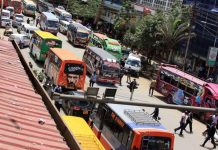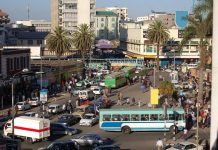The National Transport and Safety Authority has identified 273 most deadly spots for pedestrians and motorists.
The Mombasa-Malaba road, usually referred to as the Northern Corridor, has sections totalling to 391 kilometres where one is most likely to be involved in an accident.
In Nairobi, 52 kilometres of various roads are classified as black spots.
The spots have increased dramatically from 166 in 2013 because of a growing population, poor paths for pedestrians and cyclists, encroachment on road reserves and bad behaviour by road users.
A recent NTSA report profiles every accident spot and gives suggestions on saving lives.
Among the recommendations is modification of roads and proper location of hospitals.
SALGAA STRETCH
On the notorious Salgaa stretch, the authority identified a new black spot.
It is on a 9.7-kilometre straight stretch with a single bend and brow of a hill.
“The hilly section usually has slow moving vehicles. Cattle cross at some sections but there are no signs. The road markings have also faded,” the report says.
“The reasons for the many accidents at the spot include speeding, careless overtaking and unsafe pedestrian crossing. The signs are not adequate.”
Transport Principal Secretary Paul Maringa said the main reasons for accidents are human error, the condition of vehicles and road designs.
“Fixing or improving single elements such as road design and signage may not reduce crashes in future,” Prof Maringa said during the launch of the Northern Corridor and Nairobi County route mapping report.
“Equal emphasis must be placed on vulnerable road users like pedestrians, cyclists, motorbike operators, the disabled and children.”
3,000 DEATHS
He added that more than 3,000 deaths and tens of thousands of injuries recorded annually have a serious implications on society and the country’s economy.
NTSA chairman Jackson Waweru said the number of deaths from accidents decreased from 2,965 in 2016 to 2,919 in 2017, but admitted that the figure is still very high.
He added that some of the interventions implemented by the authority include enhancing road use awareness and introducing a curriculum for training, testing and licensing of drivers, instructors and examiners.
Others are the testing of drivers working for long distance travel saccos and introducing technology in most services provided by the authority, such as the Transport Integrated Management System.
“The Authority has rolled out the issuance of the smart driving licence. Finally, there is an increased road safety management and coordination through county transport and safety committees,” he said.
Mr Waweru added that passengers are the major victims of crashes on the corridor.
WET SEASONS
He said accidents take place throughout the week, during day and night and in dry and wet seasons. Nairobi has the highest number crashes.
The upgraded Outering Road is the deadliest, with more than 23 fatalities recorded since the beginning of the year.
Thika Superhighway, which is also on the list of the deadliest roads, has 16 black spots.
“There are footbridges but they are not often used by pedestrians or are constructed away from human traffic points,” the NTSA report says.
“There is also evidence of public service vehicles not stopping at designated areas. Speed bumps cause accidents, particularly during the night and weekends.”
EASTERN BYPASS
Other deadly roads in Nairobi include Landhies (Muthurwa), Jogoo, Lang’ata, Kangundo, Eastern Bypass, Southern Bypass, Mbagathi Way and Northern Bypass.
The biggest contributors of fatalities and injuries on these roads are unsafe pedestrian crossing (near roadside markets or businesses, residential areas and schools), inadequate or absence of road sign and road markings, driver behaviour (speeding, careless overtaking, obstruction by matatus, the use of undesignated bus stops and reckless motorcyclists).
The authority recommended a multi-sectored approach in reducing fatalities that includes enforcement, road construction agencies, county governments and road safety non-governmental organisations.
“Continuous monitoring of surface and maintenance of road furniture and signage is another priority,” the NTSA report says.
“Road safety audits are a useful tool in this regard.







![Top 20 Used Cars to Avoid Buying in Kenya – [PHOTOS]](../../../blog/wp-content/uploads/2013/11/top-used-unreliable-cars-to-avoid2-80x60.jpg)


![Here are some of the best tuned cars in kenya by state of the art garages [PHOTOS]](../../../blog/wp-content/uploads/2013/11/29402_10151301757042065_340470732_n-e1384498044289.jpg)

![Top 20 Used Cars to Avoid Buying in Kenya – [PHOTOS]](../../../blog/wp-content/uploads/2013/11/top-used-unreliable-cars-to-avoid2-100x70.jpg)





